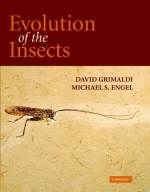
Evolution of the Insects
Cambridge University Press (Verlag)
978-0-521-82149-0 (ISBN)
- Titel ist leider vergriffen;
keine Neuauflage - Artikel merken
Insects are the most diverse group of organisms in the 3 billion-year history of life on Earth, and the most ecologically dominant animals on land. This book chronicles for the first time the complete evolutionary history of insects: their living diversity, relationships and 400 million years of fossils. Whereas other volumes have focused on either living species or fossils, this is the first comprehensive synthesis of all aspects of insect evolution. The book is illustrated with 955 photo- and electronmicrographs, drawings, diagrams, and field photos, many in full colour and virtually all of them original. The book will appeal to anyone engaged with insect diversity: professional entomologists and students, insect and fossil collectors, and naturalists.
Section 1. Diversity and Evolution: Introduction; Species: their nature and number; How many species of insects?; Reconstructing evolutionary history; Section 2. Fossil Insects: Insect fossilization; Dating and ages; Major fossil Insect deposits; Section 3. Arthropods and the Origin of Insects: Onychophora: the velvet-worms; Tardigrada: the water-bears; Arthropoda: the jointed animals; Hexapoda: the six-legged arthropods; Section 4. The insects: Morphology of insects; Relationships among the insect orders; Section 5. Earliest insects: Archaeognatha: the bristletails; Zygentoma: the silverfish; †Rhyniognatha; Section 6. Insects Take to the Skies: Pterygota, Wings, and flight; Ephemeroptera: the mayflies; †Palaeodictyopterida: extinct beaked insects; Odonatoptera: dragonflies and early relatives; Neoptera; Section 7. The Polyneopterous Orders: Plecopterida; Orthopterida; Plecoptera: the stoneflies; Embiodea: the webspinners; Zoraptera: the Zorapterans; Orthoptera: the grasshoppers, crickets, and kin; Phasmatodea: the stick- and leaf insects; †Titanoptera: the titanic crawlers; †Caloneurodea: the Caloneurodeans; Dermaptera: the earwigs; Grylloblattodea: the ice crawlers; Mantophasmatodea: the African rock crawlers; Dictyoptera; Blattodea: the roaches; Citizen roach: the termites; Mantodea: the mantises; Section 8. The Paraneopteran Orders: Psocoptera: the 'bark'lice; Phthiraptera: the true lice; Fringe wings: Thysanoptera (thrips); The sucking bugs: Hemiptera; Section 9. The Holometabola: problematic fossil orders; The origins of complete metamorphosis; On wings of lace: Neuropterida; Section 10. Coleoptera: early fossils and overview of past diversity; Archostemata; Adephaga; Myxophaga; Polyphaga; Strepsiptera: the enigmatic order; Section 11. Hymenoptera: Ants, Bees, and Other Wasps: The Euhymenoptera and parasitism; Aculeata; Evolution of insect sociality; Section 12. Antliophora: Scorpionflies, Flies, and Fleas: Mecopterida: mecopterans and relatives; Siphonaptera: the fleas; Evolution of ectoparasites and blood-feeders; Diptera: the true flies; Section 13. Amphiesmenoptera: The Caddisflies and Lepidoptera: Trichoptera: the caddisflies; Lepidoptera: the moths and butterflies; Section 14. Insects Become Modern: Cretaceous and Tertiary Periods: The Cretaceous; flowering of the world: the Angiosperm Radiations; Plant sex and insects: insect pollination; Radiations of Phytophagous insects; Austral arthropods: remnants of Gondwana?; Insects, mass extinctions, and the K/T boundary; The tertiary; Mammalian radiations; Pleistocene dispersal and species lifespans; Island faunas; Section 15. Epilogue: Why so many insect species?; The future; Glossary; References; Index.
| Erscheint lt. Verlag | 16.5.2005 |
|---|---|
| Reihe/Serie | Cambridge Evolution Series |
| Zusatzinfo | 400 Plates, color; 165 Halftones, unspecified; 100 Line drawings, unspecified |
| Verlagsort | Cambridge |
| Sprache | englisch |
| Maße | 300 x 240 mm |
| Gewicht | 2920 g |
| Themenwelt | Naturwissenschaften ► Biologie ► Evolution |
| Naturwissenschaften ► Biologie ► Zoologie | |
| Naturwissenschaften ► Geowissenschaften ► Mineralogie / Paläontologie | |
| ISBN-10 | 0-521-82149-5 / 0521821495 |
| ISBN-13 | 978-0-521-82149-0 / 9780521821490 |
| Zustand | Neuware |
| Haben Sie eine Frage zum Produkt? |
aus dem Bereich


